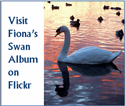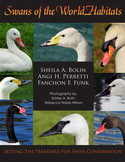Ask the Swan Specialist
Date: 27 June 2014
Hi Martin:
Yes, we do agree something stinks, and it is not the bill to stop the killings of the Mute Swans in New York. Rather, it is the despicable misinformation that has been perpetuated on the American Taxpayer based upon non-scientific research, total disregard for the truth and research conducted throughout the world by swan specialists, not general biologists. The US Wildlife Services set out in the late 90’s, early 2000’s to eradicate the Mute Swan not truthfully based upon research, but anecdotal data passed along as research.
FACT: The Trumpeter Swan, the largest swan species in the world is being brought back to the lower states for the purpose of having a “Trophy Waterfowl” to increase hunting populations and increase the number of permits that can help offset diminishing wildlife budgets. Kill the Mute Swans so that their habitats can be overtaken by introduced Trumpeter Swans.
FACT: Mute Swans are no more detrimental to the environment or aggressive than any other waterfowl species such as ducks and geese (Perrins, 2014, Nolet, 2014, Nilsson, 2014, Coleman, 2014), do not displace other waterfowl and do not eat as much vegetation as a Trumpeter Swan. Trumpeter Swans will chase and even kill Mute Swans and other swan species as well as waterfowl, intentionally or unintentionally due to their inherent large size (Bolin et al, 2014, Handrigan, 2014. A Mute Swan weighs approximately 30 lbs and eats approximately 8 lbs of aquatic vegetation daily. Trumpeter Swans weigh approximately 40 lbs and their cygnets alone will eat approximately 20 lbs of aquatic vegetation daily (Gillette, 2014, Trumpeter Swan Society).
FACT: In all the years of studying Mute Swans, in many environments, we have not seen them kill any other species including ducks. Chase, yes, especially if the other species get near their cygnets. This is DEFENSIVE NOT AGGRESSIVE behavior. When Mute Swans have been introduced to a pond/lake setting, we have actually seen the increase in other native waterfowl such as coots, egrets, herons, moorhens and ducks. (Bolin et al, 2014).
FACT: Mute Swans are not an invasive species, rather a Sentinel species in that they alert us to problems in the environment such as the presence of heavy metals such as copper and lead (Schummer et al, 2011), and harmful microorganisms (Bolin, et al, 2014). Mute Swans are Sentinel birds. There are 10,000 Mute Swans in an area smaller than what is being considered in the killing throughout the U.S. THERE IS NO OR HAS NEVER BEEN ANY NEGATIVE ECOLOGICAL IMPACT from the swans. In Fact, SWEDEN views the Mute Swan as a SENTINEL Bird. If there population ever goes below 10,000, the government mandates biologists and other officials to research the cause of their population loss. SWEDISH officials have recognized for years that the Mute Swans indicate when there is something wrong or a change in the environment. (L. Nilsson, Researcher Biodiversity Wetlands International Sweden)
The International Swan Symposium was hosted in Maryland in February 2014. The Symposium hosted some of the world’s foremost swan specialists and researchers in the world. During the Symposium, statements were made by state DNR officials on how the killings were carried out in their states. The two most statements came from Maryland, Wisconsin, and Michigan DNR officials.
HINDMAN, et. al Spraying Corn Oil on Mute Swan Eggs to Prevent Hatching Hindman Maryland DNR Director of program under US Wildlife Services
Reduce 60% hatching, removal swan using lethal methods, 2 nesting pairs left at this time. Since 2011-2013 1,683 nest destroyed, 9,403 eggs destroyed. AUDIENCE PARTICIPANT ASKED: Had the ecology of the Chesapeake Bay improved. HINDMAN’S RESPONSE: NO RESEARCH, only ANECDOTAL DATA.
The Audience participant asked Mr. Hindman:
Was there ever a NEPA study completed as stated in the Federal Lawsuit. Hindman stated that lawsuit did not affect us; it was directed toward US Wildlife Services. Participant asked him if there was ever a report. Hindman stated No. Hindman then went on to state that his graduate student (2010) using 18 test sites on the Mid-eastern Shore of the Chesapeake showed that there had been some impact. 18 test sites (how big were the test sites and only on one shore???)
HINDMAN Maryland DNR Citizen Awareness and Opinions about Chesapeake Bay Mute Swans
Hindman stated that only 652 Maryland residents were surveyed prior to the killing of the Mute Swans in the Chesapeake Bay. Audience member asked only 625 people surveyed? Did the general public ever know? Hindman’s response: Did not do any widespread information, kept it out of the media and away from the general public, got the endorsement of Governor Erhlich “We did it under the radar, most people did not know how, when or what we were doing until it was over, we went it, did what we had to do and got out. Never announced and never appeared on 6:00 news.”
9,403 eggs destroyed by oiling, 1600+ nests destroyed and Mute Swans killed by someone sitting in a helicopter and oiling eggs and nests throughout the Chesapeake Bay area. What is the cost of a helicopter flying for one hour? How much taxpayer monies were used to fly the helicopter, staff salaries, equipment, etc.? Look into this and the numbers will be astronomical at a time when most state budgets cannot afford roads, school teachers and police/fire personnel.
And yet, NO RESEARCH ever conducted. The NEPA study that the federal judge requested the U.S. Wildlife Services to conduct prior to the killings was never conducted and the research that the judge called “junk science” has been perpetuated throughout the various states to the taxpayers and media.
FACT: A Mute Swan homologue was found in fossils dating back 25 million years ago and discovered in various U.S. states. Yet, US Wildlife Services refuse to consider any information or data that shows the Mute Swans are a native species. Without taxpayer knowledge, the US Wildlife Services passed legislation through Congress to remove the Mute Swan from native species status based upon the refusal to recognize any research or other information showing the Mute Swans to be native or able to migrate across the Bering Straits. The Trumpeter Swans breed in Alaska and winter in British Columbia. The Trumpeter Swans are not inhabitants nor were they ever in certain areas that the Wisconsin, Michigan, Ohio, Illinois, Indiana, Minnesota and other DNR’s along with U.S. Wildlife Services introduced in the 90’s. Here is the actual statements made by Wisconsin and Michigan DNR officials at the International Swan Symposium. I have also attached the title of their paper presentations:
SUMNER MATTESON et. al Wisconsin’s Trumpeter Swan Recovery Program. State and Federal Wildlife Officials went to Alaska, collected Trumpeter Swan eggs, incubated them at Milwaukee Zoo and set about introducing the Trumpeter Swans to Michigan, Ohio, Minnesota, Wisconsin, Illinois, and Indiana in the 90’s.
DAVE LUUKKONEN, ET. Al - MICHIGAN DNR Mute Swan Population Growth in Michigan in Relation to Management Intensity. SPONSORED BY US WILDLIFE SERVICES AND MICHIGAN DNR
Their original plan was to reduce the (Mute) numbers by 2000 in 2030. However, stated that presently, the numbers are stable. However, in 2007, came up with another plan to kill more by 2030. They have already killed 26,000 birds. 2006< 50 individuals, 2006-2009 200-425 killed 2012- 2,628 dead 2013, 2,177
AVERS Michigan DNR Using Public Engagement, Outreach, and Collaboration to Support Management of a Rapidly Increasing Mute Swan population in Michigan (Sponsored by MDNR & US Wildlife)
Basically, educated the media and public through canned information so that could limit misinformation, population guides, negative impacts, management policies and goals, etc. Stated the following negative impacts:
Ecological impact- Sub Aquatic Vegetation (SAV)
Displaced native waterfowl and other waterfowl
Aggressiveness toward Humans
Reduce to 0 on state lands
Less than 2,000 by 2030 – She stated they would never get to this number under present plan
Policy revision in 2010
Spoke about doing things differently than Maryland by engaging public, got public, private property owners, hunters, wildlife biologists, animal activists, etc. to buy into plan. Used canned same consistent message.
Politicians had to be presented framed risks for decision making. They were more interested in other invasive species such as fish, plants, etc., and had to be given frame by frame risk to get them on board: the framed risk: aggression, invasive species, etc.
Reached stability with present plan. Then, revised plan to cull more.
ASKED BY PARTICIPANT: Were they going to go ahead and kill more than was agreed upon if it still was not socially or politically acceptable. Aver’s answer was Probably. So, even after getting agreement with the above public and private sector, and the Mute Swan population was stable, the Michigan DNR revised the plan and will go forward with killing more Mute Swans without the above entities’ acceptance.
ASKED BY PARTICIPANT: WHAT was the overall cost of controlling Mute Swans and reintroducing species? LUUKKONEN stated he did not know. The participant pressed again and these figures were provided by AVERS: US Agriculture paid $100,000-125,000 to control the Mute Swan species. Not counting staff salaries, Michigan DNR $25,000. No cost of reintroduction of the Trumpeter Swans was provided, an overall budget was provided, there was no year to year breakdown as this program has been on-going at taxpayer expense since the late 90’s and mid-2000’s. How much was spent year to year? Avers also noted that this program was going to run out of funding in the next few years.
So, if you are spending enormous amounts of money, why engage in a project that you know cannot be sustained financially?
These are statements made by state DNR officials. Many more statements contradicting the research perpetuated throughout the U.S. were made by other DNR officials at the Symposium. So, yes, we agree, it does stink and the American taxpayer is footing the bill for the odor!
The Regal Swan
Messages In This Thread
- News: New York State Senators pass bill to stop the killing of Mute Swans in NY today -- The Regal Swan -- 18 June 2014
- Re: News: New York State Senators pass bill to stop the killing of Mute Swans in NY today -- The Regal Swan -- 19 June 2014
- Re: News: New York State Senators pass bill to stop the killing of Mute Swans in NY today -- Lynne -- 19 June 2014
Ask the Swan Specialist is powered by
Tetra-WebBBS 5.30 Beta © 2006-2007 Tetra-Team






